Monday Mantids
Double-click on any image to view it full size. Click the back-button to return to your place on this page.
Greetings!
If you have been reading these essays for three years, and if you have a good memory, you may recognize two of the images in this set, and some of the words. However, this is the “New, Improved” version so hopefully everyone will find something of interest.
Perhaps it is just me, but I think there is something quirkily endearing about these creatures, with their faces and poses that almost seem to be human (Image #1).
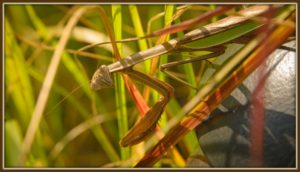
It turns out that in the Mid-Atlantic area there are three species of mantises one may find – typically all three are referred to as praying mantises, even though technically that name only applies to one of the two non-native species – Mantis religiosa. The other non-native species, which is also the largest of the three, is the Chinese Mantis – Tenodera aridifolia – (also refered to in some sources as Tenodera aridifolia sinensis or just Tenodera sinensis) while the only native species in this area is the Carolina Mantis – Stagmomantis carolina. For those of you, like me, who love to know the derivation of words, mantis comes from a Greek word meaning “soothsayer” or “prophet, aridifolia allegedly comes from two Latin words meaning “green dragon” and “leaf”, Sinensis comes from the Latin for “Chinese”, Tenodera means “slender neck”, but I have not been able to determine the derivation of the “stagmo” part of stagmomantis.
All three mantis species in the area start life by hatching in the spring from an egg-mass (the technical term is an ootheca) laid the previous year. Several years ago a friend (thank you, Lynn!) gave me such an ootheca in a small plastic container (with a perforated top for ventilation), and one morning I found the container full of tiny Chinese Mantis nymphs – Picture 2.
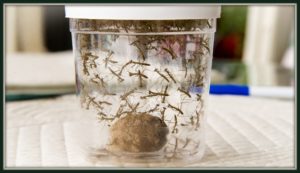
Each baby mantis was about half an inch long. I released these nymphs outside as quickly as possible, since left to themselves they have a habit of eating each other!
When they first hatch, baby mantises do not have wings. Over the spring and summer the nymphs go through several molts until reaching adult size. Picture 3 shows an almost-adult Chinese Mantis with its “wing buds” just developing. They can be seen about half-way along its body.
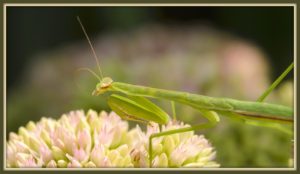
This particular individual is also in the act of cleaning its antenna by drawing it through its mouth. Like all insects, mantises have six legs but the front pair are modified into jack-knife-like weapons with a formidable array of spikes and barbs. When fully extended, these front legs are surprisingly long, as shown in image #4.
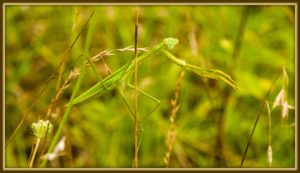
All three species can be found in various shades of green and/or brown, and identification becomes even more complicated when one adds-in the wingless pre-adult (nymph) stages. Based on several years of photographing these creatures, I believe that I do not actually have a picture of a Mantis religiosa – almost all my images are of the Chinese Mantis, with the remainder being of the Carolina Mantis. Picture #5 shows, I believe, a Carolina Mantis.
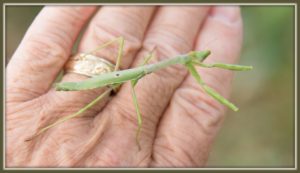
As I walked through a wooded area near our cottage on Topsail Island I felt something land on my leg. Resisting the immediate urge to swat it (the wood is full of mosquitoes and biting flies) I looked down and saw this mantis, which I gently scooped off with my left hand, leaving me to get the camera adjusted and operated with my right hand only. (That’s my excuse for the indifferent quality of the image!) At first I thought the black spot with a white margin on the wind was a scar or blemish, but it turns out this mark (technically a stigmata), and wings that do not cover the entire abdomen, identify this as a Carolina Mantis.
Those of you who are familiar with the basics of Latin taxonomy will recognize that the three species mentioned so far (of the 2400 species found world-wide) belong to three different genera. The creature shown in picture #6 looks rather like a praying mantis, but it is actually a Green Mantisfly (one of the species in the genera Zeogomantispa), and is not related to praying mantises.
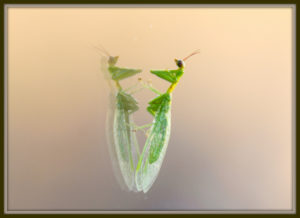
To get this picture, I had to lean out of our 11th floor window to photograph the individual clinging to the outside of the window, and I could not avoid the multiple reflections from the double window glass. These are fascinating creatures, and I strongly urge you to go to http://www.insectidentification.org/insect-description.asp?identification=Green-Mantisfly for a description of its behavior!
So with all that said, what about identifying the specimen in picture #7?
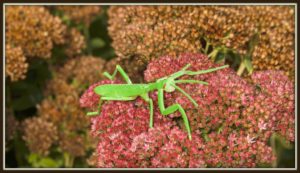
I was able to get close enough to flip it over, leaving no doubt as to its origin – picture #8!

Mantises are often regarded as being highly beneficial in gardens because of their appetite for insects, and Chinese Mantises especially have been deliberately introduced in some areas to fight insect pests. However, opinion seems to be shifting a bit because their cannibalistic tendencies mean they are rarely present in large enough numbers to be very effective, and they also are equally happy, when not eating each other, devouring “good” insects like honey-bees and butterflies – there are even documented cases of them ambushing hummingbirds! Picture #9 shows a (green form) Chinese Mantis chowing-down on a Bumble Bee.
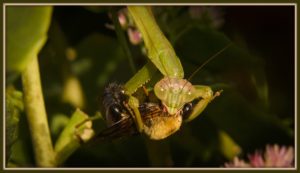
The brown form individual in #10 looks like it is saluting, or shading its eyes, but is actually licking the last remains of its previous meal from its legs.
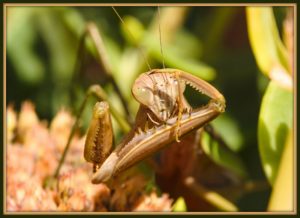
In spite of their large size, mantises are extremely well camouflaged, and can be very difficult to spot. This week’s final picture, #11, shows a juvenile (undeveloped wings), with its body almost exactly duplicating the stem of the detached flower.
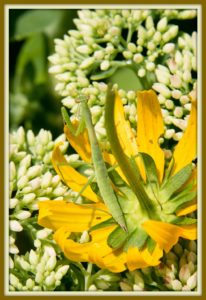
Have a great week!